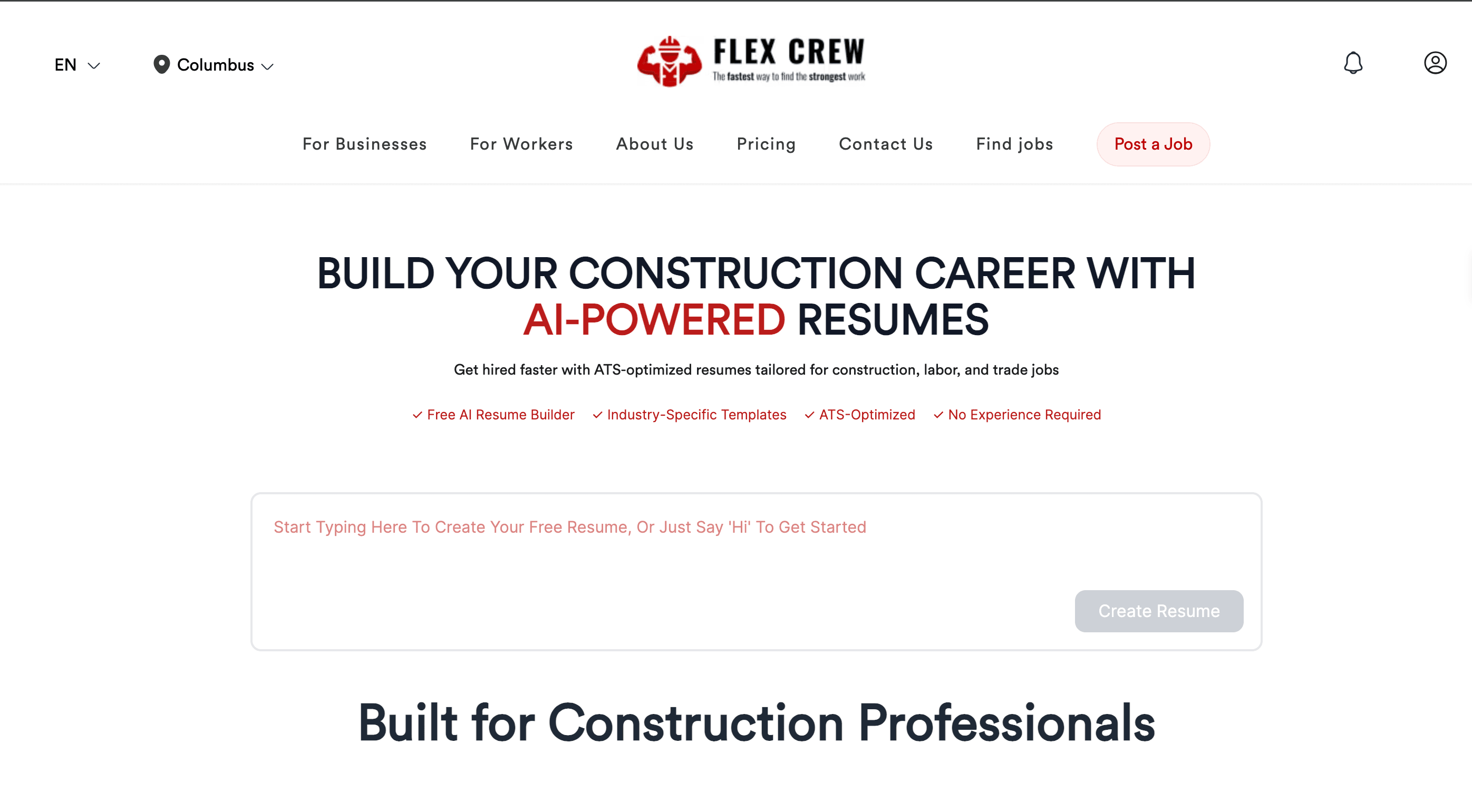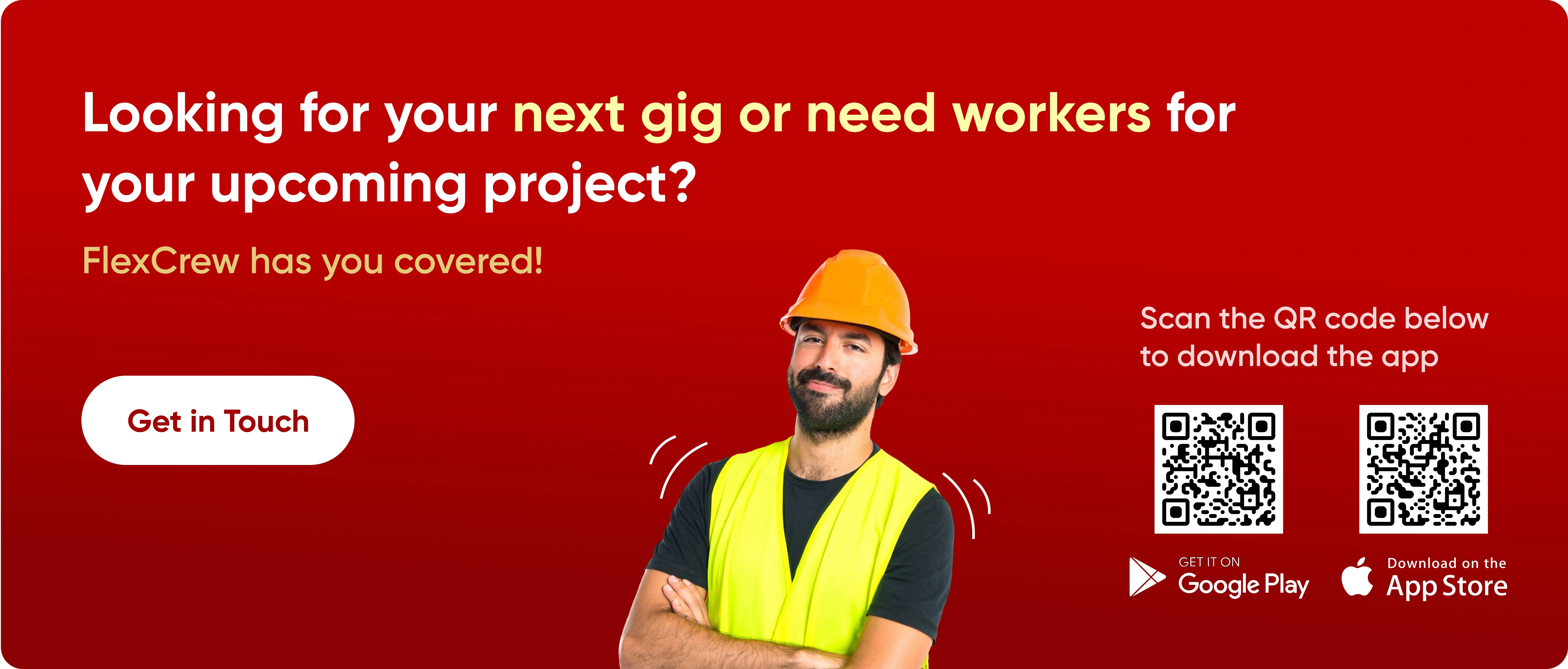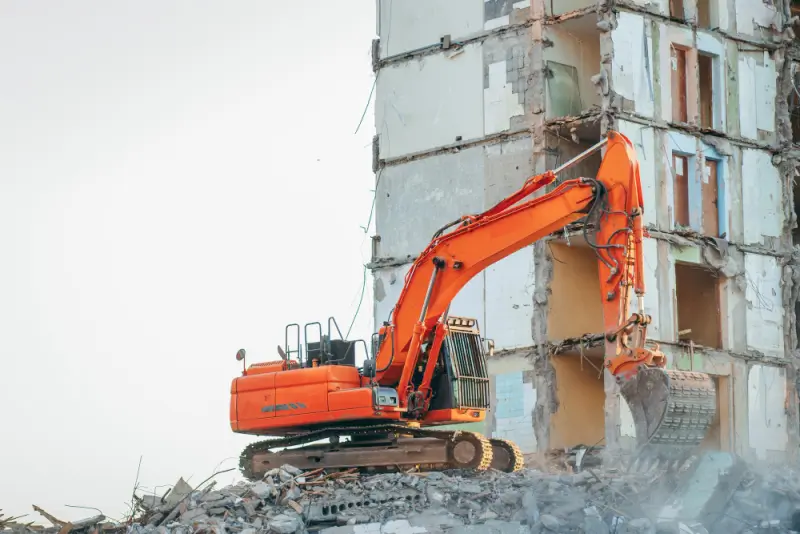Getting hired in construction isn't just about your skills with a hammer or your ability to read blueprints. It's about having a resume that gets you through the door. Whether you're a seasoned foreman or just starting out as a laborer, your building construction resume is the foundation of your job search.
Here's the reality: hiring managers spend about six seconds scanning each resume. That's less time than it takes to measure a 2x4. Your resume needs to grab their attention fast, showcase your skills clearly, and prove you're worth bringing in for an interview.
What Makes a Building Construction Resume Stand Out?
A strong building construction resume does more than list where you've worked. It tells the story of your hands-on experience, safety record, and ability to get the job done.

Construction employers want to see specific things. They're looking for OSHA certifications, equipment you can operate, types of projects you've completed, and measurable achievements. If you reduced project delays by 13% or completed nine consecutive builds ahead of schedule, those numbers matter.
Your resume also needs to pass the Applicant Tracking System (ATS) before a human ever sees it. Use a single-column layout, skip fancy graphics, and include keywords from the job description. Simple, clean, and easy to read wins every time.
FlexCrew USA's AI Resume Builder makes this process simple. Instead of wrestling with Microsoft Word formatting for hours, you can create an ATS-friendly resume in minutes, with industry-specific suggestions built right in.
Building Construction Resume Format That Gets Interviews
Format matters more than you think. Use reverse-chronological order—your most recent job comes first. This format works best for construction workers because employers want to see your latest experience and skills.
Keep it to one page if you have less than 10 years of experience. If you're a construction managerwith extensive project history, two pages is acceptable. Just make sure every line adds value.
Save your resume as a PDF unless the job posting says otherwise. PDFs won't scramble in transit like Word documents sometimes do. Name your file professionally: "John_Smith_Construction_Resume.pdf" instead of "resume.pdf."
Use clear section headers: Contact Information, Professional Summary, Work Experience, Skills, Certifications, and Education. Make it scannable with plenty of white space and bullet points.
Crafting Your Professional Summary
Your professional summary sits at the top of your resume, right under your contact information. This 2-3 sentence paragraph is prime real estate. Make it count.
Skip generic openers like "hardworking construction worker seeking opportunities." Instead, lead with your strongest qualifications. Include years of experience, specific skills, and a standout achievement.
Here's what works: "OSHA-certified construction worker with 8+ years of experience in residential and commercial builds. Proven track record of reducing project delays through early issue identification and proactive communication. Skilled in heavy machinery operation, framing, and blueprint interpretation."
For entry-level workers without much experience, use a career objective instead. Focus on your passion for the trade, relevant training, and what you bring to the table. Mention the company by name to show you're genuinely interested in working there.
Try FlexCrew USA's AI Resume Builder to generate professional summaries tailored to your experience level and the specific construction job you're applying for.
Building Your Work Experience Section
This is where you prove your value. List your most recent position first, including your job title, company name, location, and dates of employment.
Use bullet points to describe your responsibilities and achievements. Start each bullet with an action verb: operated, completed, managed, reduced, increased, built, installed.
The real secret? Quantify everything you can. Instead of "worked on residential construction projects," write "completed 15 residential builds valued at $60,000-$200,000, finishing 90% ahead of schedule."
Numbers make your accomplishments real. How many team members did you supervise? What was the square footage of the building? How much did you reduce material waste? What percentage did you improve safety compliance?
If you're transitioning from another field or have limited construction experience, focus on transferable skills. Did you handle heavy equipment in a warehouse job? Manage teams in retail? Work outdoors in landscaping? Connect those dots.
Common mistakes to avoid:
- Using passive voice instead of action verbs
- Listing job duties without showing results
- Going back more than 10-15 years
- Including irrelevant work history
- Writing paragraph form instead of bullets
Essential Skills for Your Building Construction Resume
Your skills section is where you showcase both hard and soft skills. Hard skills are tangible abilities you've learned—operating a backhoe, reading blueprints, concrete mixing, framing. Soft skills are personal qualities—teamwork, communication, problem-solving, dependability.
Top technical skills to include:
- Heavy machinery operation (excavators, bulldozers, forklifts, cranes)
- Blueprint and schematic reading
- OSHA safety compliance
- Power tool proficiency
- Concrete work and foundations
- Framing and carpentry
- Electrical and plumbing basics
- Site preparation and grading
- Materials handling
- Quality control inspection
Essential soft skills:
- Team collaboration
- Time management
- Problem-solving under pressure
- Attention to detail
- Physical stamina and endurance
- Adaptability to changing conditions
- Communication with supervisors and crews
Pull keywords directly from the job description and weave them into your skills section. If the posting mentions "scaffold installation" or "drywall expertise," and you have that experience, include it.
FlexCrew USA's AI Resume Builder analyzes job descriptions and suggests the most relevant skills to include based on your experience and the position requirements.
Certifications That Make You Hireable
Construction certifications prove you're trained, qualified, and serious about safety. List every relevant certification with the issuing organization and date.
Most valuable construction certifications:
- OSHA 10-Hour or 30-Hour Construction Safety
- Forklift Operator Certification
- CDL (Commercial Driver's License)
- First Aid and CPR
- Confined Space Entry
- Fall Protection Training
- Scaffold Erection
- Crane Operator Certification
- NCCER certifications (for specific trades)
Even if a certification is expired, you can list it with the original date and note "renewal in progress" if applicable. Certifications set you apart from other candidates, especially for specialized positions.
Education Section for Construction Resumes
Most construction jobs don't require a four-year degree, but you should still include your education. List your highest level of education—high school diploma, GED, trade school, or college degree.
Include the name of the school, location, and graduation year (unless it's more than 15 years ago). If you completed relevant coursework in construction technology, engineering, or architecture, mention it.
Apprenticeships deserve special attention. If you completed a formal apprenticeship program under certified builders or through a union, highlight it prominently. Include the duration, supervising organization, and skills gained.
Making Your Entry-Level Construction Resume Shine
Breaking into construction without experience is challenging but not impossible. Focus on what you do have: volunteer work, school projects, part-time jobs that show physical stamina, and any hands-on experience with tools.
Ways to strengthen an entry-level resume:
- Highlight Habitat for Humanity or similar volunteer construction work
- Include relevant coursework or trade school training
- Mention any summer jobs involving physical labor
- List sports or activities demonstrating physical fitness
- Feature hobbies like woodworking or home improvement projects
Use a career objective instead of a professional summary to express your enthusiasm for learning and growing in the construction industry. Mention specific skills you're eager to develop and why you're passionate about construction work.
FlexCrew USA specializes in placing entry-level construction workers with companies that value potential and work ethic over extensive experience. Our AI Resume Builder helps you highlight transferable skills effectively.
Tailoring Your Building Construction Resume to Specific Roles
Not all construction jobs are the same. A resume for a residential framer looks different from one for a commercial electrician or construction manager.
For residential construction workers: Emphasize fast turnaround, attention to detail, homeowner communication, and finishing work (flooring, cabinets, fixtures).
For commercial construction: Highlight large-scale project experience, coordination with multiple trades, blueprint reading, and strict safety compliance.
For construction managers: Focus on leadership, budget management, subcontractor oversight, project completion rates, and cost savings.
For specialized trades: Lead with your trade-specific certifications, years of experience in that specialty, and any union memberships.
Read the job posting carefully. If they mention "team collaboration" three times, make sure your resume shows examples of successful teamwork. If they emphasize safety, lead with your OSHA certifications and perfect safety record.
Common Building Construction Resume Mistakes to Avoid
Even experienced construction workers make resume mistakes that cost them interviews. Here's what to skip:
Don't:
- Use an unprofessional email address ([email protected])
- Include a photo (unless specifically requested)
- List personal information like age, marital status, or Social Security number
- Use first-person pronouns (I, me, my)
- Submit the same generic resume to every job
- Forget to proofread for spelling and grammar errors
- Include salary expectations or reasons for leaving previous jobs
- Go overboard with industry jargon that ATS systems might miss
Do:
- Customize your resume for each application
- Use standard fonts (Arial, Calibri, Times New Roman)
- Keep formatting consistent throughout
- Include accurate contact information
- Proofread multiple times (or have someone else review it)
- Update your resume regularly with new skills and certifications
How to Write a Building Construction Resume in 30 Minutes
You don't need to spend days creating a resume. Here's a fast-track approach:
Step 1 (5 minutes): Gather all your information—job history, certifications, skills, education, contact details.
Step 2 (10 minutes): Choose a clean, ATS-friendly template. FlexCrew USA's AI Resume Builder offers construction-specific templates that are proven to get results.

Step 3 (10 minutes): Fill in your sections, using action verbs and quantifiable achievements. Let the AI suggest skills and phrases based on your experience.
Step 4 (5 minutes): Proofread, check formatting, and save as a PDF.
The AI Resume Builder does the heavy lifting—suggesting industry keywords, catching formatting issues, and ensuring your resume passes ATS screening. You focus on the content, and the tool handles the rest.
Maximizing Your Building Construction Resume's Impact
Your resume is just the first step. Pair it with a strong cover letter that expands on your most impressive achievements and explains why you're excited about the specific company.
Follow up after submitting your application. A quick phone call or email checking on the status shows initiative and genuine interest.
Bring copies of your resume to every interview, along with your certifications, a list of references, and any required documentation. Being over-prepared demonstrates professionalism.
Network within the industry. Many construction jobs are filled through referrals before they're ever posted online. Join local trade organizations, attend industry events, and connect with other professionals.
Landing Your Next Construction Job with FlexCrew USA
The construction industry is booming. The Bureau of Labor Statistics projects 4% job growth for construction workers through 2031, with over 168,000 new positions opening annually. Demand is especially high in growing metro areas where new housing, commercial buildings, and infrastructure projects are underway.
But here's the catch: competition for the best-paying jobs is fierce. You need more than experience and certifications. You need a building construction resume that showcases your value in seconds.
FlexCrew USA's AI Resume Builder gives you the edge. Our platform:
- Creates ATS-friendly resumes optimized for construction jobs
- Suggests industry-specific keywords and action verbs
- Offers pre-written content tailored to your experience level
- Provides real-time feedback on resume strength
- Generates multiple resume versions for different job types
- Ensures proper formatting that passes applicant tracking systems
Stop wrestling with resume templates. Stop wondering if your resume will make it past the ATS. Stop losing out on interviews because your resume doesn't showcase your skills effectively.
Build your winning construction resume in under 30 minutes with FlexCrew USA's AI Resume Builder. Our tool has helped thousands of construction professionals land interviews with top employers across the country.
Frequently Asked Questions About Building Construction Resumes
Q: How long should my building construction resume be?
A: One page is standard for workers with less than 10 years of experience. If you're a construction manager or have extensive specialized experience, two pages is acceptable. Never exceed two pages.
Q: Do I need to include every job I've ever had on my construction resume?
A: No. Focus on the last 10-15 years and prioritize construction-related experience. If you have older experience that's highly relevant, include it. Otherwise, a simple "Previous experience includes..." line is sufficient.
Q: What if I don't have formal OSHA certification yet?
A: Note "OSHA certification in progress" if you're actively pursuing it. Entry-level positions often don't require certifications upfront, but showing you're working toward them demonstrates commitment to safety and professional development.
Q: Should I list soft skills or just technical skills on my building construction resume?
A: Include both. Technical skills prove you can do the work. Soft skills like teamwork, communication, and problem-solving show you'll fit well on a crew and handle jobsite challenges effectively.
Q: How do I explain employment gaps on my construction resume?
A: Be honest but brief. If you were injured, caring for family, or between projects, a simple one-line explanation works. Focus on any skills or certifications you gained during that time. Construction work is often project-based, so some gaps are expected.
Q: Can I use the same resume for different construction jobs?
A: You shouldn't. Customize your resume for each position by emphasizing the most relevant skills and experience. Use FlexCrew USA's AI Resume Builder to quickly create tailored versions for different job types.
Q: Do construction employers care about volunteer experience?
A: Yes, especially for entry-level candidates. Habitat for Humanity, community building projects, or church construction work shows hands-on experience and commitment to the trade.
Q: What's the best format for submitting my construction resume online?
A: PDF format prevents formatting issues when opened on different devices. Only use Word format (.doc or .docx) if the job posting specifically requests it.
Q: How often should I update my building construction resume?
A: Update it every time you gain a new certification, complete a significant project, or change jobs. Keep a master resume with all your experience, then customize shorter versions for specific applications.
Q: Where can construction workers in Texas, Florida, California, or other states find the best resume help?
A: FlexCrew USA's AI Resume Builder works for construction professionals nationwide. Our platform is optimized for local job markets across all 50 states, with templates and keywords that resonate with regional employers and meet state-specific requirements.
Ready to build a resume that opens doors? Try FlexCrew USA's AI Resume Builder today and join thousands of construction professionals who've landed better jobs, higher pay, and more opportunities. Your next career move starts with the right resume—create yours now in just minutes.



